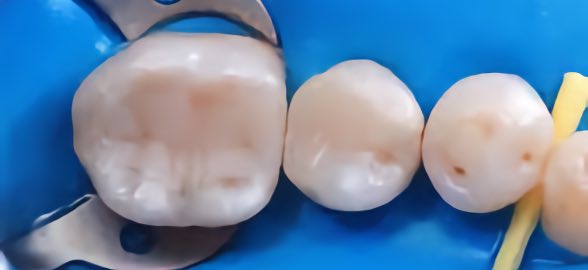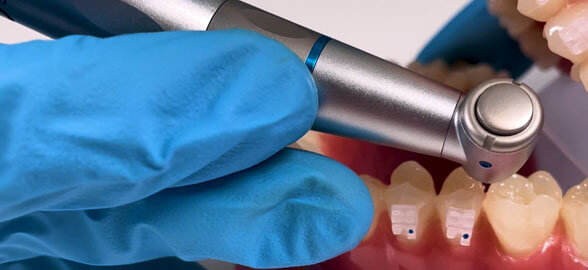Did you know that dental wax is used in many different ways? And not only that, but they all have their own characteristics, properties, compositions and indications. In this article we will tell you everything about dental waxes and how to classify them according to their use, so that it is much easier for you to find the most appropriate dental wax for each clinical or laboratory application. Let us begin!
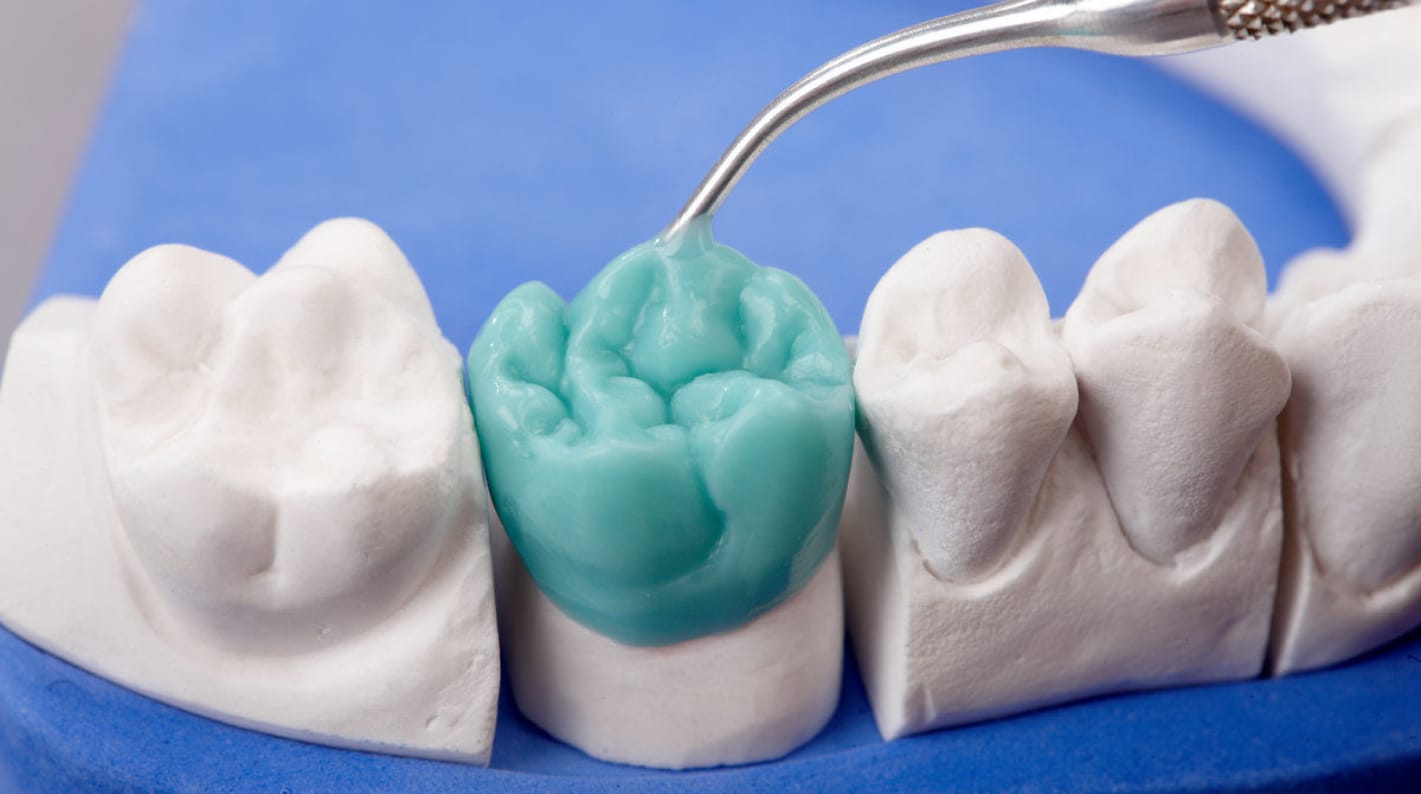
What are dental waxes and what are their physical properties?
Dental waxes are chemical polyesters of fatty acids and alcohol forming hydrocarbon chains, that is, chains of carbon atoms linked to each other and to hydrogen atoms or other radicals. There is a wide variety of waxes for dental use and in general terms, we could say that most of them are made up of a mixture of waxes of animal, vegetable and mineral origin, as well as other products such as oils, fats, gums, resins, synthetic waxes and dyes.
The different types of dental waxes share the same physical properties:
- Melting range: Dental waxes are made up of different molecules and although they are similar to each other, they have different molecular weights. This property means that, instead of having a specific melting point, they have melting intervals.
- Thermal expansion: Dental waxes expand with increasing temperature and contract with decreasing temperature.
- Fluidity: It is what happens when the molecules slide over each other. The degrees of fluidity vary according to the type of wax, temperature and time.
- Residual stress: Cooling the wax under compression forces the atoms and molecules closer together and reheating the wax releases the stress, causing a dimensional change.
- Ductility: If you increase its temperature you can stretch the wax like a wire.
- Distortion of the wax pattern: Distortion increases with time and also depends on the storage temperature. This occurs because the residual stress developed during the fabrication of the wax pattern is released.
Types of dental waxes
We can classify waxes according to their use as:
- Pattern wax
- Wax for processing
- Impression wax
1. Pattern wax
The dental waxes for patterns have three main types:
1.1 Wax for inlays or wax for modeling fixed prosthetics
1.2 Casting wax
1.3 Baseboard wax
The inlay wax or fixed prosthesis modeling wax is used to build the shape of a dental restoration on a previously prepared die in a stone model, which is then Through a laboratory process, you will transform this wax pattern into a definitive restoration made of a resistant material such as a metal alloy or porcelain. This process in simple terms consists of creating a wax pattern with the desired shape, then it is lined with plaster-silica or another type of refractory material, to make a mold with a casting hole that connects the external surface of the mold with the pattern. The wax is removed by heating and melting it, and finally, the mold is prepared to receive the molten alloy.
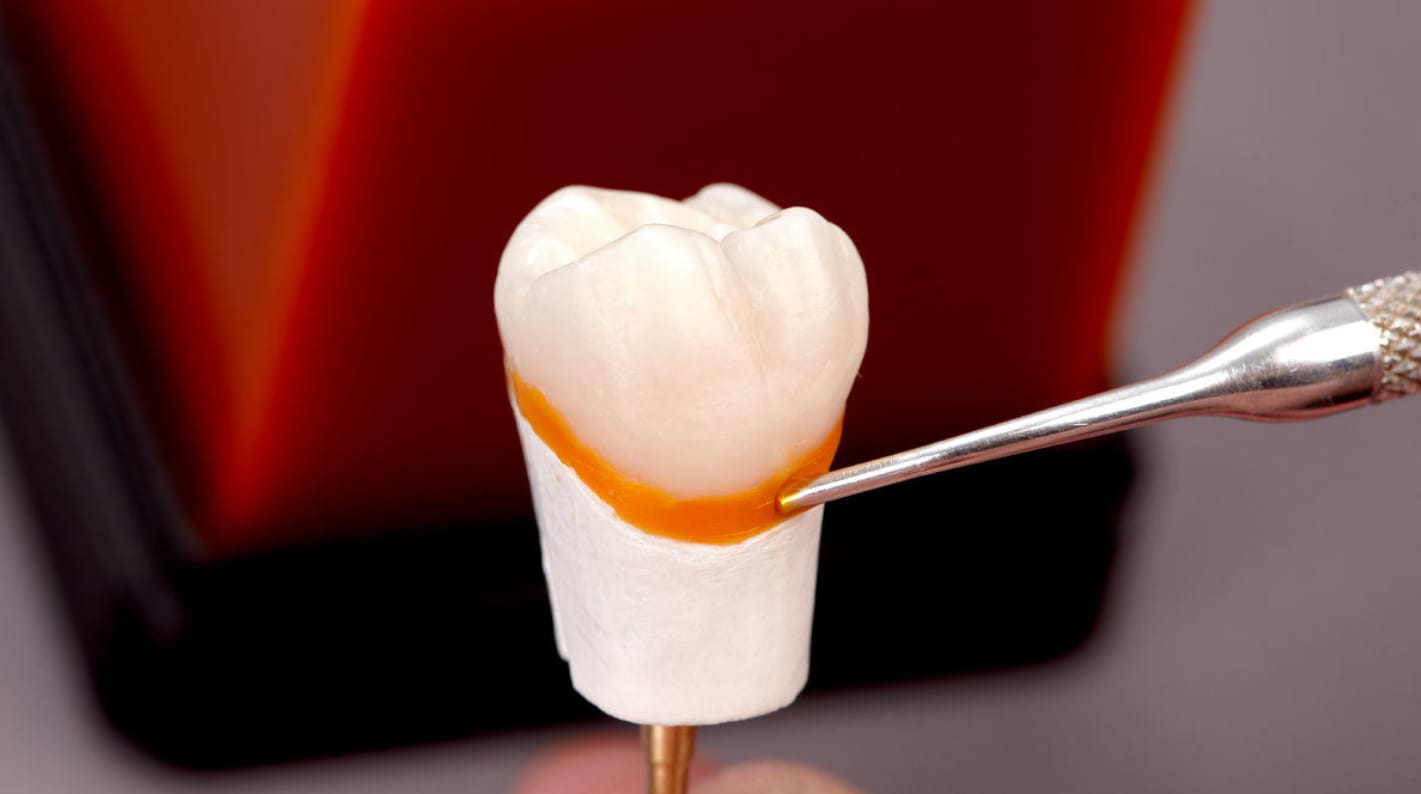
Regarding its composition, paraffin is usually its main component, reaching from 40 to 60% of its weight, but since paraffin tends to flake and does not have a smooth and shiny surface as required by wax scales, it is necessary that its remaining weight percentage be other waxes and natural resins as modifying agents.
There are two types of waxes for inlays:
- Type I: it is harder, is used directly in the mouth and has low levels of fluidity.
- Type II: is softer, is used indirectly in the stone model, and is more fluid.
What to look for when choosing a good modeling wax?
The fixed prosthesis modeling wax in its soft state must be free of lumps, this indicates that it is composed of ingredients that are mixed evenly. The color of the inlay wax should contrast with the die, this sharp contrast helps to carve more precise margins.
It is necessary to discard waxes with excess paraffin, when the wax is bent and molded after softening, no flakes should appear on its surface, the surface should be smooth. Furthermore, it must be capable of being carved to a very fine layer, it must not chip during carving, as this would prevent an exact pattern. Finally, it is important that the chosen wax provide a stiff wax pattern.
Our recommendation for modeling waxes:
Thowax: Yeti Modeling Wax
Yeti Thowax modeling wax is ideal for all your fixed prosthesis modeling work such as inlays, bridges and crowns, as it has a high molecular density which makes it easy to scrape, leaving clean shavings and smooth surfaces.
- Ideal for modeling crowns, bridges and inlays.
- Wax free of synthetic ingredients.
- Fast cooling for more efficient work.
- Easily modelable, even for very fine details.
- 70 gram can, available in different colors
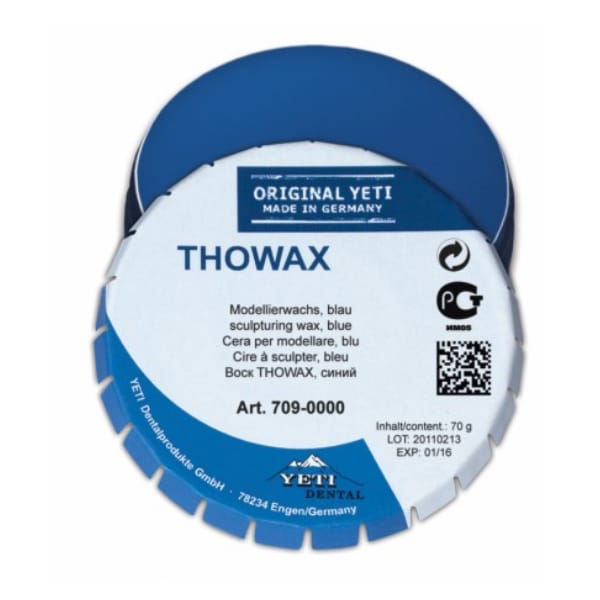
1.2 Casting Wax
The pattern for the metallic bases of removable partial dentures and other similar ones is made with casting waxes. Wax sheets are used to establish a minimum thickness in certain base areas, such as the lingual and palatal bars, and to achieve the desired contour on the lingual bar. They are also used to make preformed elements for closures and retainers of different sizes.
There are 3 different types of casting waxes:
- Class A: number 28, pink
- Class B: number 30, green
- Class C: smooth forms, blue
What to look for when choosing a good casting wax?
Mainly that they are sticky, since this allows them to maintain their position and adhere to the model without the need to use wax adhesives. The thickness and type of roughness must be chosen according to the work to be done.
Our recommendation for casting waxes:
Technowax Protechno: Calibrated smooth wax for casting
The fine calibrated wax of the Protechno brand comes in green sheets of 75 x 150 mm.
- Smooth wax in calibrated plates / sheets
- Box of 15 units.
- Different thicknesses from 0.3 mm to 0.8 mm
- Ductile and workable
- Does not leave residues in the cast.
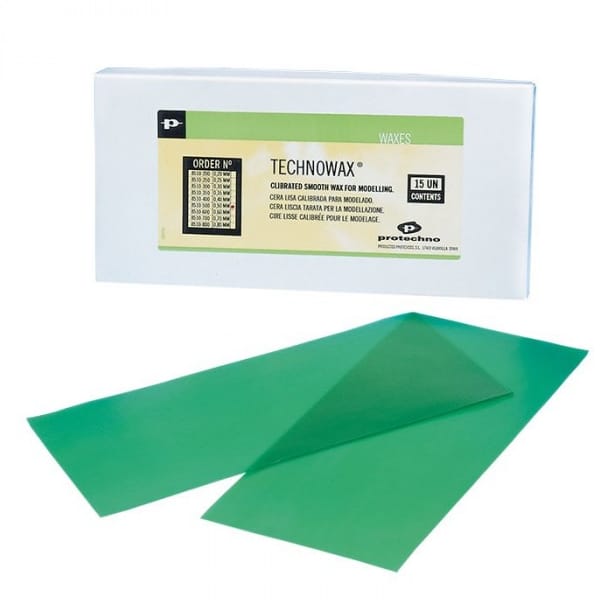
1.3 Baseboard Wax
The baseplate wax gets its name from the fact that it is used on the base of the plate to define the vertical dimensions, the occlusal plane, and the initial arch shape in the fabrication of a complete prosthesis. It is usually a pink color that offers an aesthetic appearance during the initial construction of the denture before being processed. With this wax, the desired shape of the prosthesis can be modeled after placing the teeth. Therefore, the modeled wax establishes the mold for the final acrylic prosthesis.
It is essentially composed of paraffin, normally in a proportion of 70 or 80%, 12% beeswax, 2.5% carnauba wax, 3% natural or synthetic resin and 2.5% microcrystalline or synthetic waxes.
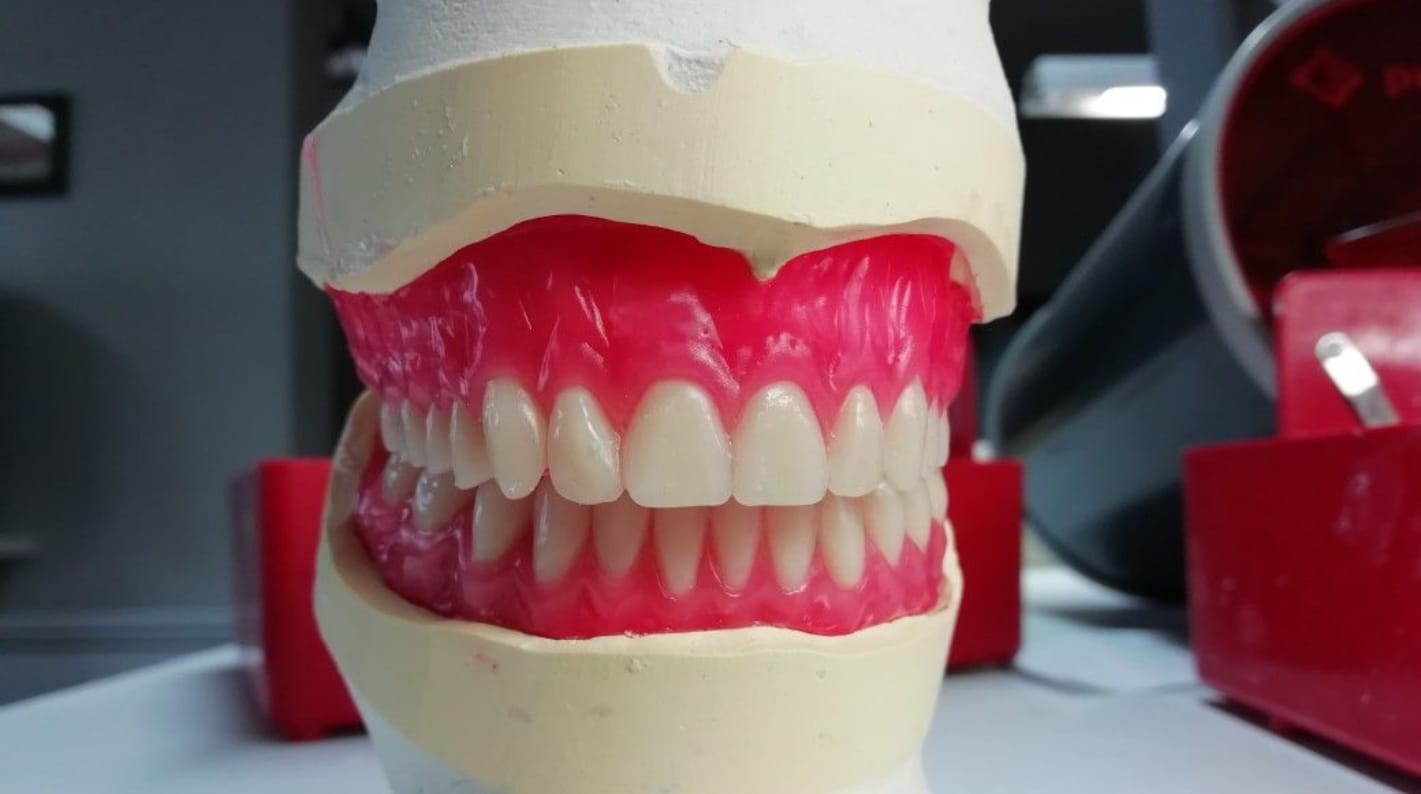
There are 3 types of base plate wax:
- Type I: soft, used for the preparation of contours and veneers.
- Type II: medium, used to make patterns inside the mouth, temperate climates.
- Type III: hard, used to make patterns inside the mouth, hot climates.
What to look for when choosing a good baseboard wax?
The key to choosing a good baseboard wax is fluidity which is of great importance especially in waxes that are used to make patterns that are tried in the mouth, make sure you choose a wax that do not have excessive fluidity, as this could induce changes in the vertical dimensions and occlusion. We also recommend choosing a wax that is easy to work with depending on the climate you are in.
Our recommendation for base plate wax:
Reus 450 g pink modeling wax
Reus pink wax is a modeling wax used to make dental prostheses, it has excellent elasticity and adherence. There are three options available: the regular version, a special version for hot climates with high temperatures, and another for colder climates, which differ in their melting point to ensure adequate elasticity and optimal adhesion.
- Pink rectangular sheets.
- Ideal for modeling dentures.
- Melting point 59/60º C.
- 450 gram box, 20 sheets.
- Also available Reus wax for cold climates.
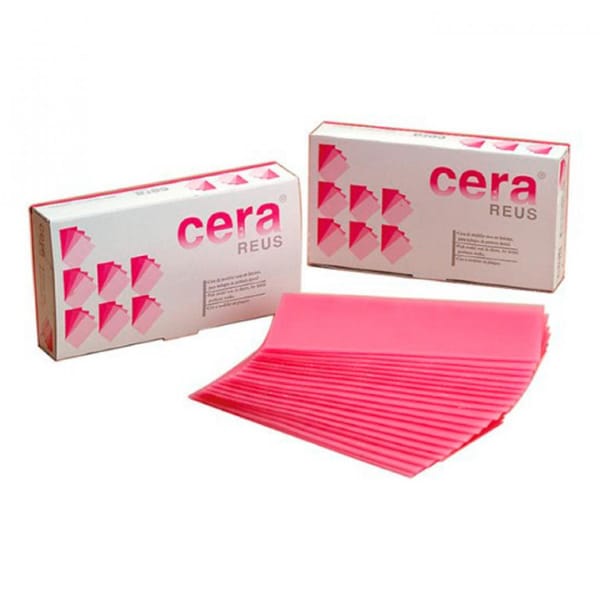
2. Wax for processing
Dental waxes for processing are mainly of three types:
- Formwork wax
- Utility wax
- Sticky wax
2.1 Formwork Wax
Cauring is a procedure used to surround the impression material and its base to confine the stone and define a shape and thickness to minimize model trimming. In addition, it ensures the correct reproduction of the print in terms of its peripheral sealing.
The walls of the formwork are made with formwork wax, which has the particularity of being able to easily adapt around the impression.
What to look for when choosing a good formwork wax?
The most important thing about a enframing wax is that, when flaming it, a smooth and shiny surface is achieved, which is flexible at 21º C but maintains its shape at 35º C. In addition, it must be able to be easily attached to the plaster and, of course, not melt due to the heat that the plaster emits in its setting process.
Our recommendation for formwork waxes:
Coltene Regular Boxing Wax
Cola Boxing Wax from Coltene is used to form the impressions, it has the particularity of being a wax that supports the heat that the dental stone emits during its setting, without melting.
- Indicated for maintaining the peripheral seal by extending the impression tray.
- 1.6 mm x 38.4 mm x 305 mm sheets.
- Box of 450 grams.
- Resistant to the setting heat of the dental plaster.
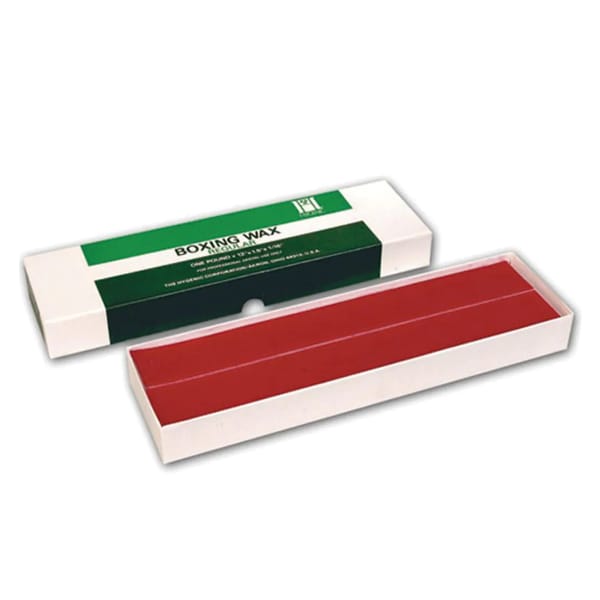
2.2 Utility wax
The utility wax, is an adhesive wax used to prevent warping and distortion of the material. Its usual presentation is in the form of red or orange bars or sheets. It consists mainly of beeswax, petroleum jelly and soft waxes. Also included in this category are orthodontic waxes used by patients, making small balls and placing them on the brackets, especially in the early stages of treatment, to protect the mucosa and avoid chafing.
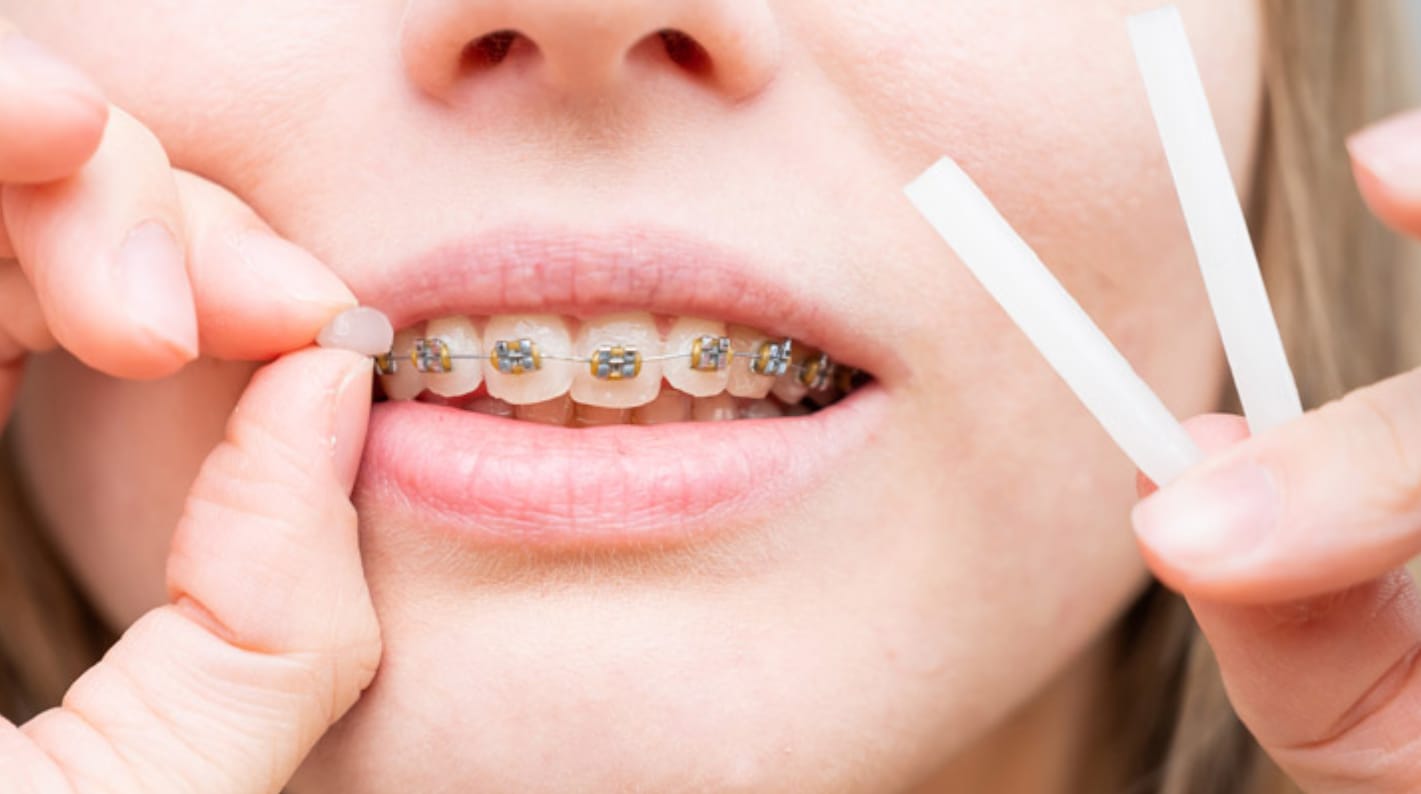
What to look for to choose a good utility wax?
One of the most important things to keep in mind when choosing a utility wax is that it has to be flexible and sticky from 21 a 24ºC, and it must also be able to adhere to make repairs on small damages and fill gaps.
Our recommendation for utility waxes:
Vidu Utility wax for orthodontics
The Vidu utility wax in bars, thanks to its individual box packaging with 5 sticks, is especially indicated for orthodontic patients to help protect their oral mucosa from possible friction caused by brackets, wires, arches or other devices.
- Reduces patient discomfort.
- Natural composition, without aromas, without adverse effects in case of ingestion.
- White color.
- 50 boxes of 5 sticks each.
- Made in the USA.
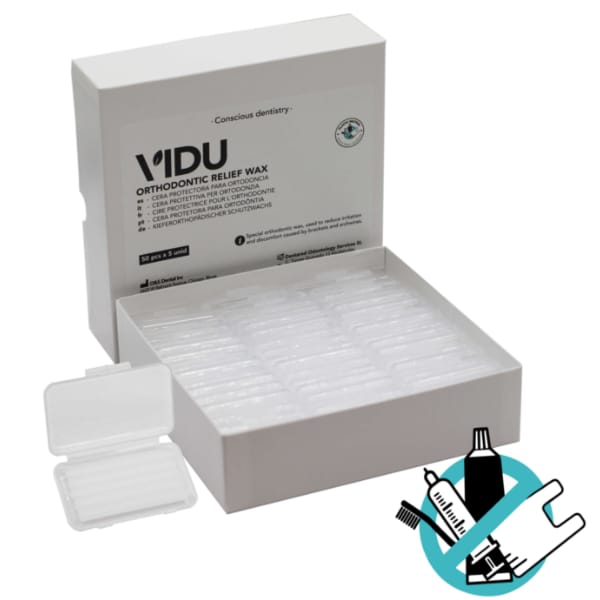
2.3 Sticky Wax
The sticky waxes are used to bond metal or plastic parts to a temporary fixed position. They can also be used to repair structures, fix models in the articulator, hold bridges and dies. Its commercial presentation is usually in dark yellow bars.
Its composition consists of a mixture of waxes and resins, rosin, beeswax and dammar gums.
What to look for when choosing a good sticky wax?
To choose an optimal sticky wax we must take into account that it is sticky in the molten state and that it is capable of adhering closely. In addition, it must not leave more than 0.2% residue after combustion and have very low shrinkage, ideally no more than 0.5%, when it goes from 42 to 28º C.
Our sticky wax recommendation:
Kerr Sticky Wax 12 bars
Kerr Sticky Wax is a fast-setting, hard wax used to repair structures.
- Contains 12 bars, 27.7 grams.
- Yellow color.
- It is excellent for attaching spouts to their bases.
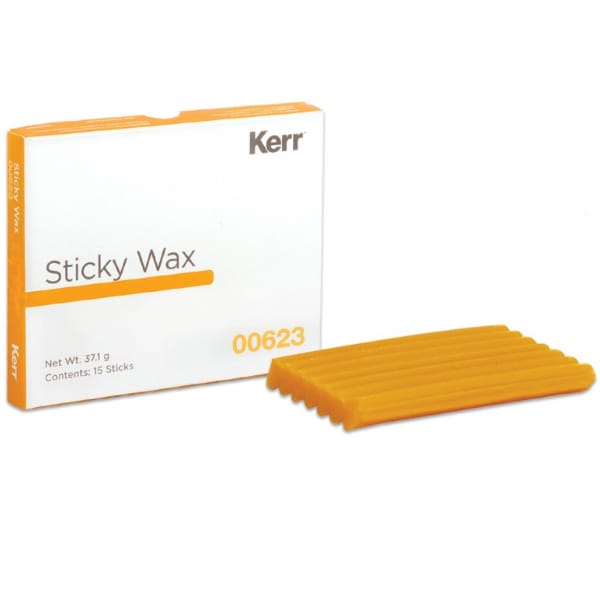
3. Impression wax
Impression waxes can be classified into two:
- Wax to correct impression
- Bite registration wax
3.1 Wax to correct impression
The impression corrective wax is used to dress the impression and come into contact with the soft tissues in a functional state to register them. It is composed of hydrocarbon waxes such as paraffin and ceresin, and may contain metallic particles. The wax is fluid at 37ºC and deforms when removed from the mouth.
What to look for to choose a good corrective wax?
Make sure that the corrective wax you choose is soft and comfortable to avoid irritation or discomfort in the patient's oral mucosa. It is also important that it have good adhesion and support, to provide an optimal fit.
Our corrective wax recommendation:
Godiva Kerr Wax Sticks
Kerr's Godiva Modeling Compound is a thermoplastic material for functional impressions or for applying to the rim of an impression tray.
- Available red and green, each with a controlled working temperature.
- Red: temperature 55 °C.
- Green: temperature 50 °C.
- Contains 15 units, 113 grams.
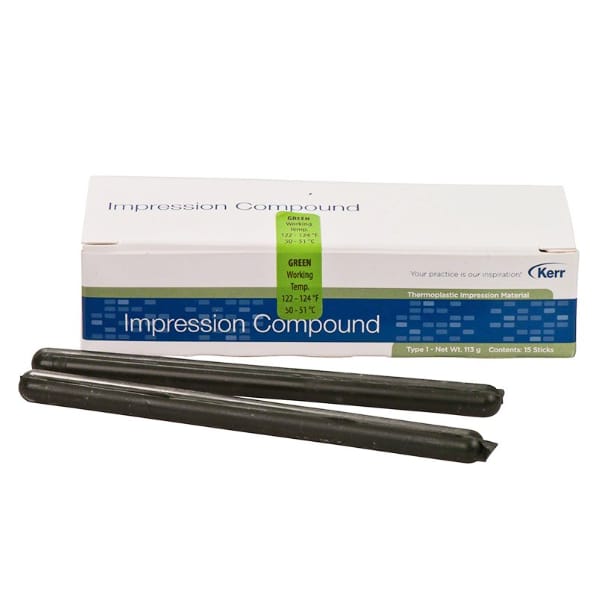
3.2 Wax for bite registration
The bite registration wax is used to accurately fit opposing quadrant models. Bite registrations are normally made with #28 casting wax or base plate wax and there are also special waxes for registering bites that may contain beeswax, hydrocarbon waxes, paraffin or ceresin, and some of them include aluminum or copper particles. The fluidity of the different bite registration waxes varies between 2.5% and 22% at 37°C, which means that they can deform when removed from the mouth.
What to look for to choose a good wax for bite registration?
A bite registration wax should not shrink or distort as it hardens at room temperature. It must also be easy to use and strong to reposition on the patient's teeth if the accuracy of the registration is to be tested. The ideal for this type of wax for bite registration is that they are rigid at room temperature and that at working temperature they are soft and do not lose their properties, in order to obtain a sharp and exact cusp impression.
Our recommendation for bite registration wax:
Yeti Soft Bite Wax Stick
Yeti soft bite registration waxes heat tenaciously and when cooled are very stable in shape, to ensure the highest registration precision.
- Ensures an accurate bite registration.
- Lemon aroma, better accepted by the patient.
- 108 x 10 x 10 mm stick.
- Yellow color.
- Contains 490 grams.

Dental waxes are highly versatile materials that undoubtedly facilitate daily work in the clinic and in the dental laboratory. Now that you have become a true expert in dental waxes we are sure that it will be even easier for you to find the one you need.
Remember that at Dentaltix we have a wide variety of types and brands of dental waxes, we invite you to take a look. If you have questions or there is something we can help you with, do not hesitate to contact us and also follow us on our social networks to continue reading articles of interest to you. Until next time!



